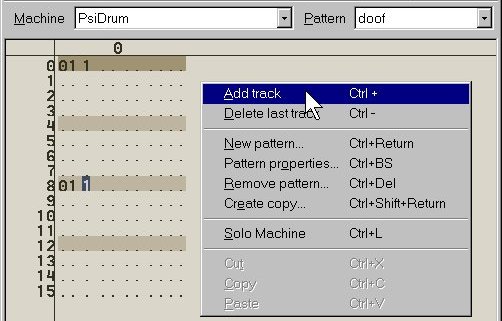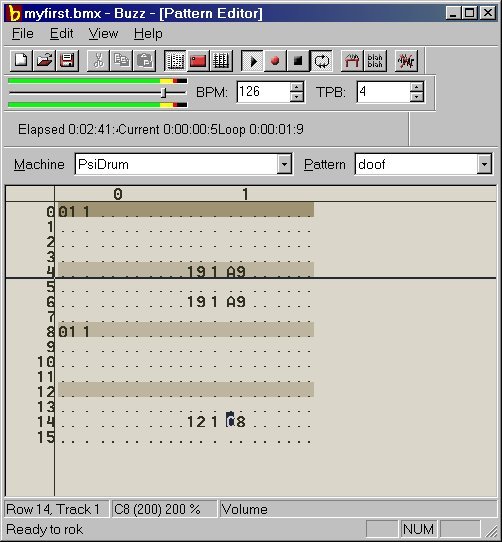
There are lots of ways to add cymbal (or hats) to a sequence. I chose the PSIDrum as it contains not just drum samples but also other percussion instruments as well.
Within the doof pattern, we need to add another track - this will allow me to play other sounds at the same time as sounds are playing (like layering). To add a track in an existing pattern, right-click on the pattern editor desktop and select the add track option:

The first track we created was named track 0, so the new track will be track 1. In it, we can define a pattern that is to be played at the same time track 0 is being played:

In the example above, I have added triggers inbetween my doofs, and chosen samples 19 and 12 (both satisfactory tish -like sounds). As I added these triggers, Buzz plays them in real time. You will notice I have also added volume parameters which tweak the cyms making some softer than others.
You may have noticed that the number system used in Buzz is a little different to that which you are used to. All parameter values are entered in Hexadecimal - a base 16 number system. Below is a decimal-hexadecimal comparison grid:
|
1
|
2
|
3
|
4
|
5
|
6
|
7
|
8
|
9
|
10
|
11
|
12
|
13
|
14
|
15
|
16
|
17
|
18
|
19
|
20
|
21
|
22
|
23
|
24
|
25
|
26
|
27
|
28
|
29
|
Decimal
|
|
1
|
2
|
3
|
4
|
5
|
6
|
7
|
8
|
9
|
A
|
B
|
C
|
D
|
E
|
F
|
10
|
11
|
12
|
13
|
14
|
15
|
16
|
17
|
18
|
19
|
1A
|
1B
|
1C
|
1D
|
Hex
|
Hexadecimal is confusing at first, but there is a definite pattern to the symbols used in it.
Go forward if you want to add effects to your current song....
pwhitehouse@optushome.com.au
Buzz © Jeskola
![]()